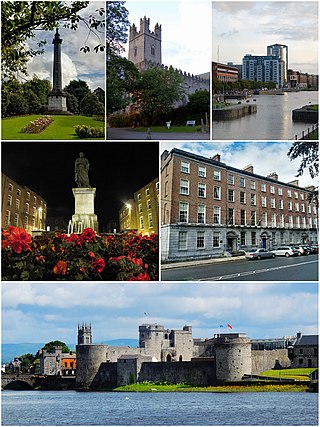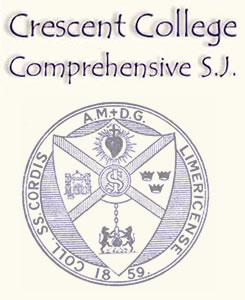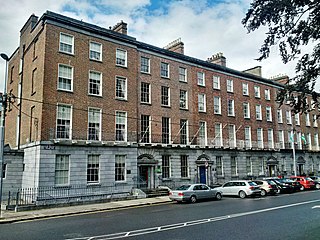Related Research Articles

Limerick is a city in western Ireland, in County Limerick. It is in the province of Munster and is in the Mid-West which comprises part of the Southern Region. With a population of 102,287 at the 2022 census, Limerick is the third-most populous urban area in the Republic of Ireland, and the fourth-most populous city on the island of Ireland. It was founded by Scandinavian settlers in 812, during the Viking Age.

Raheen is a large suburb of Limerick, Ireland. Initially developed to ease population overspill from the city of Limerick, Raheen is socioeconomically diverse, ranging from older, poor-class housing estates to relatively affluent areas.

James Kemmy was an Irish socialist politician from Limerick, who started his political career in the Labour Party. He later left Labour, was elected as an independent Teachta Dála (TD), and founded the Democratic Socialist Party, which merged with the Labour Party in the 1990s.

Limerick lace is a specific class of lace originating in Limerick, Ireland, which was later produced throughout the country. It evolved from the invention of a machine which made net in 1808. Until John Heathcoat invented a net-making machine in Devon in 1815, handmade net was a very expensive fabric. This meant cheap net became available to Irish lacemakers, particularly after 1823 when Heathcoat's patent expired.

Crescent College Comprehensive SJ, formerly known as the College of the Sacred Heart, is a Catholic secondary school located on 40 acres (160,000 m2) of parkland at Dooradoyle, Limerick, Ireland. The college is one of a number of Jesuit schools in Ireland.

The N20 road is a national primary road in Ireland, connecting the cities of Cork and Limerick. Buttevant, Croom, Charleville, Mallow and Blarney are major towns along the route. A short section of the route is motorway standard and is designated as the M20 Motorway.
The Crescent Shopping Centre is a major shopping centre serving Limerick, Ireland. It is located in Dooradoyle, on the southern outskirts of the city. The complex in its original form was opened in 1973, making it one of the earlier shopping centres to open in Ireland. It has an estimated 100,000 m2 (1,100,000 sq ft) of space, 2,500 free car parking places and 94 shops. The shopping centre takes its name from the adjacent Crescent College, whose original building was in The Crescent in the city centre.

Limerick County Council was the authority responsible for local government in County Limerick, Ireland. As a county council, it was governed by the Local Government Act 2001. The council had 28 elected members. Elections for the council were held every five years and were by single transferable vote. The head of the council had the title of Cathaoirleach (Chairperson).
Garryowen is a neighbourhood in Limerick, Ireland. The word Garryowen is a transliteration of the Irish Garraí Eoin - "the garden of Owen" - and relates to the association in the 12th century between St John's Church and the Knights Templar whose house in Limerick was dedicated to John the Baptist. In medieval times Garryowen was located just outside the Irishtown area of the walled city of Limerick. The citadel was the Irishtown's main fortification. In 1690, it was the scene of a heroic Jacobite defence-the battle of the breach-which was fought nearby during the Williamite War of 1688–91. The sally port of the original stronghold has been incorporated into the structure of St John's Hospital. Other parts of the city walls can still be seen within the hospital grounds. The Citadel remained in use as a military barracks until 1752. St John's Gate was situated on the main roadway, nearby, but no trace of it now remains.
Dooradoyle is a large suburb of Limerick, Ireland. It is one of Limerick's newer suburbs, and is home to the campus of University Hospital Limerick and the Crescent Shopping Centre.

Irish lace has always been an important part of the Irish needlework tradition. Both needlepoint and bobbin laces were made in Ireland before the middle of the eighteenth century, but never, apparently, on a commercial scale. It was promoted by Irish aristocrats such as Lady Arabella Denny, the famous philanthropist, who used social and political connections to support the new industry and promote the sale of Irish lace abroad. Lady Denny, working in connection with the Dublin Society, introduced lace-making into the Dublin workhouses, especially among the children there. It is thought that it was an early form of Crochet, imitating the appearance of Venetian Gros Point lace.

Limerick Museum, previously known as the Jim Kemmy Municipal Museum, is a city museum in Limerick, Ireland.

Limerick City Gallery of Art is an art museum in the city of Limerick, Ireland. It is run by Limerick City Council and is located in Pery Square, in the Newtown Pery area of the city.

The Crescent is a street in Limerick, Ireland and is one of the highlights of Georgian Limerick. The area takes its name from the shape of the terraced buildings on both sides. The two sides combined give the street a distinctive crescent oval shape. The Crescent was originally known as Richmond Place . A monument to Daniel O'Connell; the 19th Century Irish political leader stands at the centre of The Crescent overlooking O'Connell Street. On the west side is the Church of the Sacred Heart, a former Jesuit church that closed in 2006. In 2012 the church was bought by a new religious order known as the Institute of Christ the King Sovereign Priest who hope to restore the church. Adjoining the Church of the Sacred Heart was Crescent College run by the Jesuit Order. It is now located in Dooradoyle suburbs. The site is now occupied by Limerick Tutorial College, a fee paying private school.

Limerick City and County Council is the authority responsible for local government in County Limerick in Ireland. It came into operation on 1 June 2014 after the 2014 local elections. It was formed by the merger of Limerick City Council and Limerick County Council under the provisions of the Local Government Reform Act 2014. As a city and county council, it is governed by the Local Government Act 2001. The council is responsible for housing and community, roads and transportation, urban planning and development, amenity and culture, and environment. The council has 40 elected members. Elections are held every five years and are by single transferable vote. The head of the council has the title of Mayor. The city and county administration is headed by a Chief Executive, Pat Daly. The administrative centre is City Hall, Limerick, with other civic offices at Dooradoyle. Following a plebiscite in 2019, Limerick is due to become the first local authority in Ireland with a directly elected mayor.
Florence Vere O'Brien was a British diarist, philanthropist, and craftswoman. She set up The Limerick Lace School and Clare Embroidery.
Limerick Museum and Archives (LM&A) was a partnership between two separate and distinct institutions, the Limerick City Museum and the Limerick Archives, which existed from 2013 and 2017. Both are funded by Limerick City and County Council.
Matthew Potter is an Irish academic who serves as the current curator of Limerick Museum. He is a published historian with a primary focus on governmental history and is an Honorary Fellow of the Department of History of the University of Limerick.
The Civic Offices is a municipal facility in Dooradoyle, Limerick, County Limerick, Ireland.

The People's Museum of Limerick is a local history museum in Limerick, Ireland.
References
- ↑ "Collection List". Limerick Archive. Archived from the original on 2 March 2015. Retrieved 8 May 2022.
- ↑ Fleming, David; Logan, John, eds. (2011). Pauper Limerick, The Register of the Limerick House of Industry, 1774-1793. Dublin: Irish Manuscript Commission. ISBN 978-1-906865-10-8 . Retrieved 13 January 2015.
- ↑ "Online archive of Limerick's history launched". Limerick Leader. Archived from the original on 24 January 2015. Retrieved 8 May 2022.
- ↑ "Digital Collection". Limerick Archives. Archived from the original on 2 March 2015. Retrieved 8 May 2022.
- ↑ Halloran, Cathy (5 May 2021). "Archive of Limerick East Brigade chief Sean Wall online". RTÉ.ie . Retrieved 8 May 2022.
- ↑ "Decade of Centenaries Projects". www.Limerick.ie.
- ↑ Potter, Matthew (2014). Hayes, Jacqui (ed.). Amazing Lace: A History of the Limerick Lace Industry. Limerick: Limerick City Council. ISBN 9780905700229 . Retrieved 13 January 2015.
- ↑ "Amazing Lace, a history of Limerick Lace by Dr Matthew Potter • Events".
- ↑ "Dress". Limerick Lace. Retrieved 8 May 2022.
- ↑ "Mount Saint Lawrence Burial Register". Limerick. Archived from the original on 22 August 2013. Retrieved 8 May 2022.
- ↑ Slater, Sharon (18 August 2013). "Guide to Using the Mount Saint Lawrence Register". Limerick's Life. Retrieved 8 May 2022.
- ↑ "Beyond the Grave". Craft in Ireland. 2014. Archived from the original on 4 March 2016. Retrieved 8 May 2022.
- ↑ "Welcome". Mount Saint Lawrence Cemetery. Retrieved 8 May 2022.
- ↑ Owens, Alan (16 January 2014). "Haselbeck collection captures 'glazed streets' of Limerick's past". Limerick Leader. Archived from the original on 8 August 2014. Retrieved 8 May 2022.
- ↑ Gilleece, Emma (2014). Limerick City Of Churches. Limerick: Limerick Archives. p. 78. Retrieved 13 January 2015.
- ↑ Launch of City of Churches, Limerick Leader
- ↑ "These images from 1970s Limerick are fantastic". The Journal. 24 September 2014. Archived from the original on 27 September 2014. Retrieved 8 May 2022.
- ↑ "Home". From Limerick with Love. Retrieved 8 May 2022.
- ↑ "Information". So Limerick. Archived from the original on 22 March 2015. Retrieved 8 May 2022.
- ↑ Dwane, Mike (14 March 2013). "Records from Limerick's St Joseph's Hospital transferred to archives". Limerick Leader. Archived from the original on 8 August 2014. Retrieved 8 May 2022.
- ↑ Whelan, Edward (2012). Hayes, Jacqui (ed.). Ranks Mills: The Industrial Heart of Limerick City. Limerick: Limerick City Council. ISBN 978-0905700205.
- ↑ "Ranks: A Limerick Industry". The Hunt Museum. Archived from the original on 7 May 2012. Retrieved 8 May 2022.
- ↑ Lynch, Richard (21 February 2013). "'Ranks Mills, The Industrial Heart of Limerick City' Exhibition wins award". I love Limerick. Retrieved 8 May 2022.